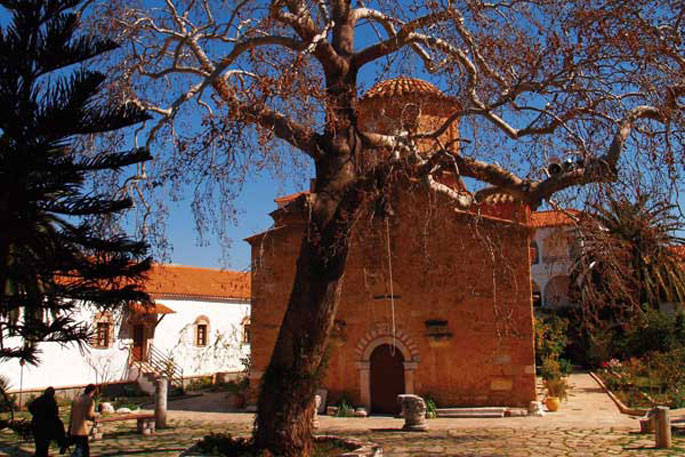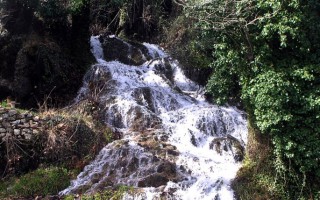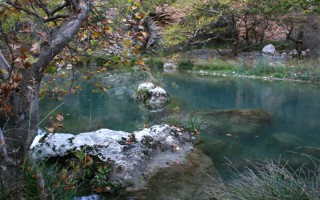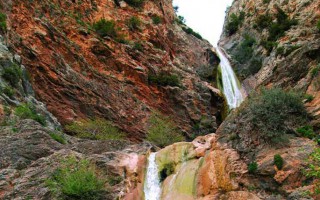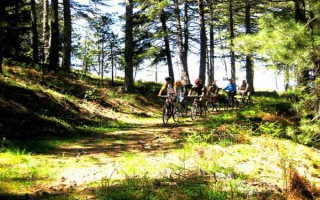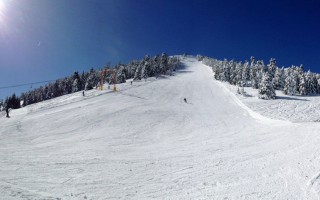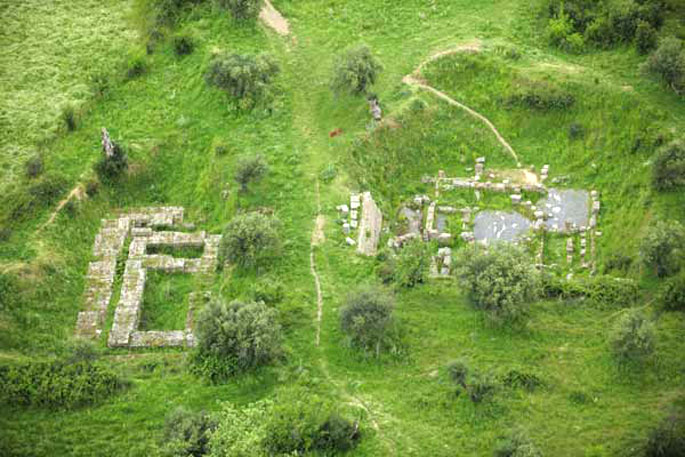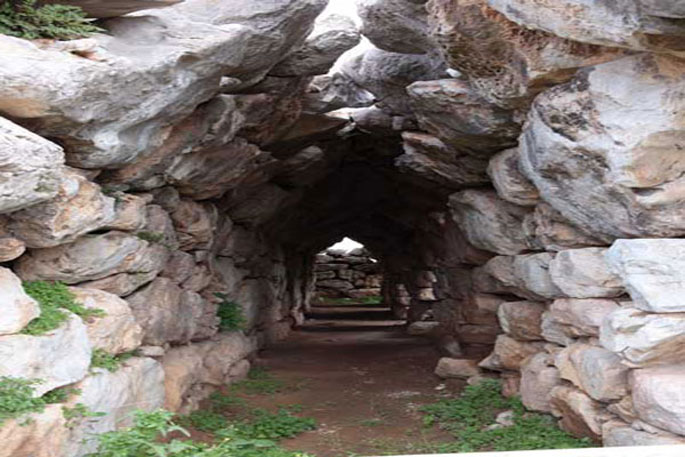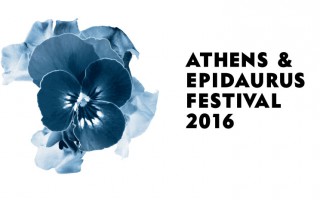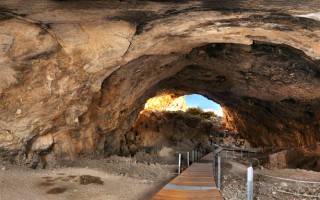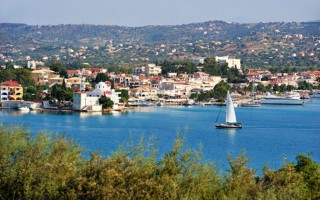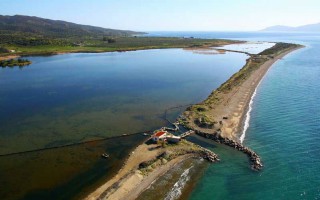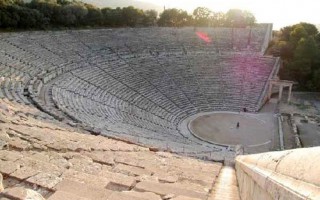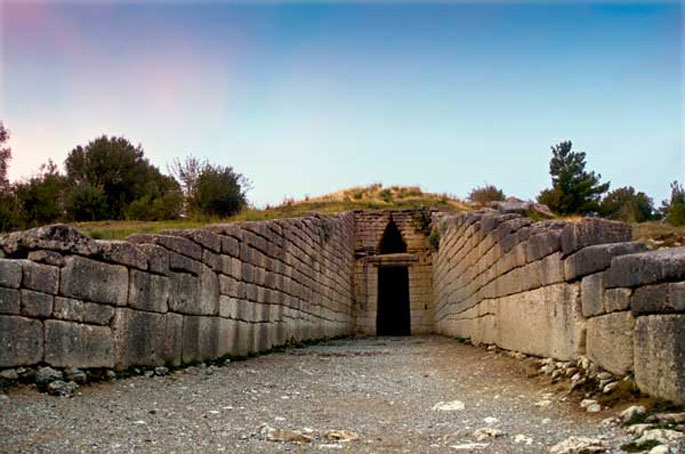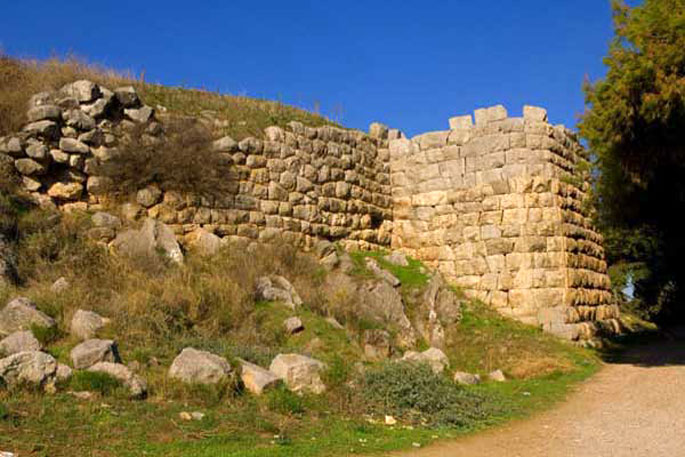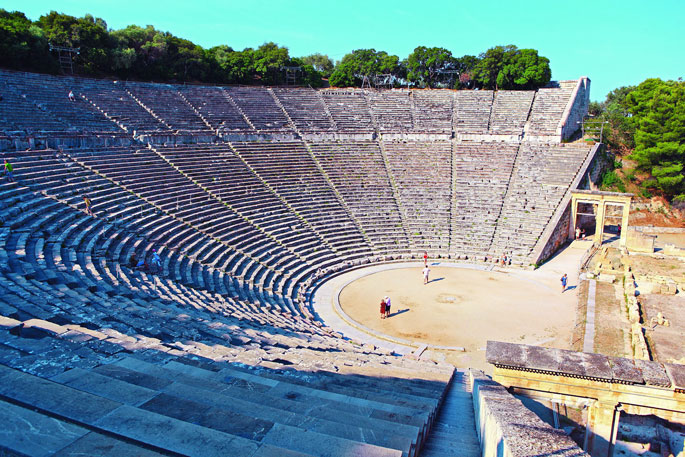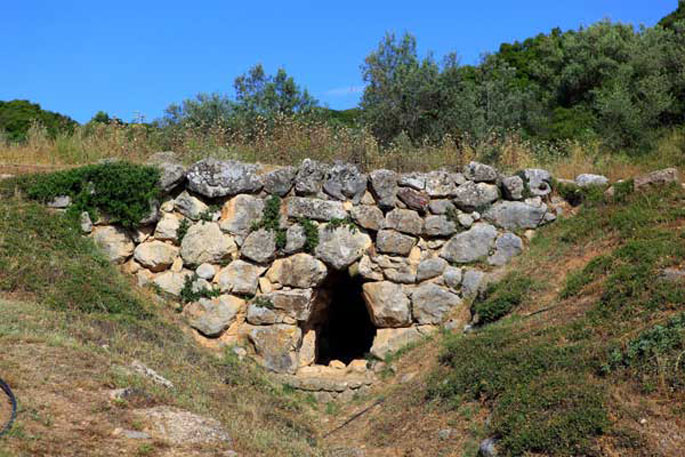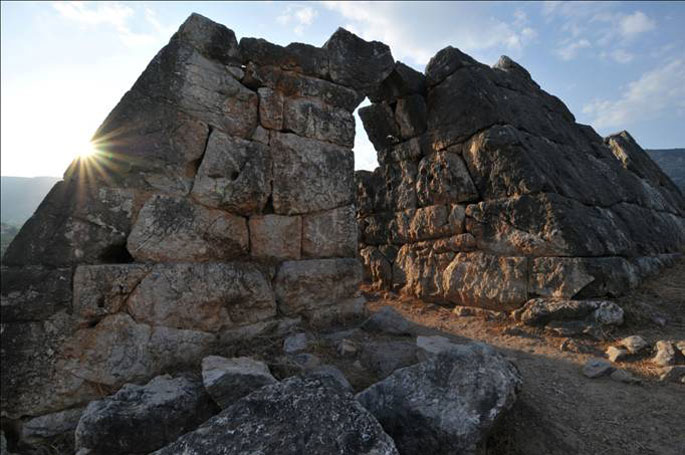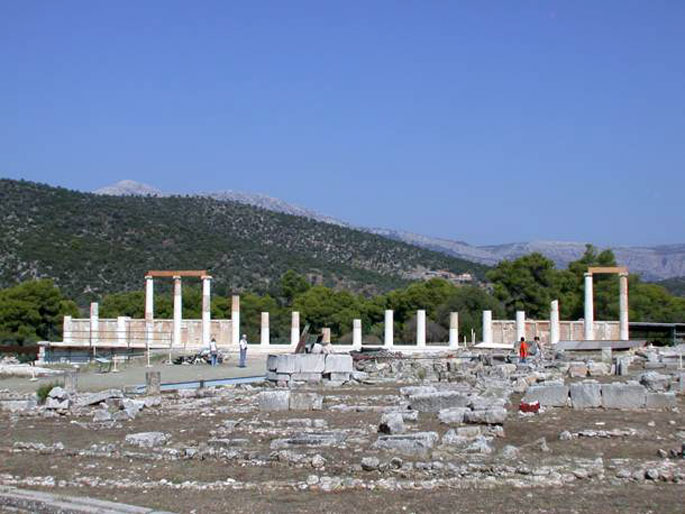The Mansion of Herod Atticus is one of the most important and most impressive monuments in Arcadia. It is situated in Eva, in Doliana, an ancient town of Kynouria, which has been completely lost, but for a few samples of habitation. The mansion’s location was already known from the 19th century, however it was identified with certainty in 1906 by archaeologist Constantine Romeos.
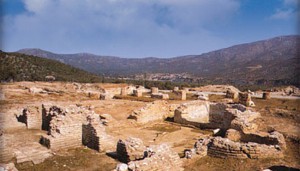 Herod Atticus, orator, philosopher and politician from a wealthy family, was also a fanatical collector of works of art. From his father he inherited a small mansion in Eva, which he decided to expand and to house his vast collection there, turning it into a sort of luxury museum. The mansion takes up approximately 20,000 m2 and includes a villa, a sanctuary, baths and a large atrium with galleries. The most impressive of all, however, are the mosaic floors; the total expanse of those discovered so far exceeds 1,300 m2. As the excavations and the research continue, it is very possible that others will come to light as well.
Herod Atticus, orator, philosopher and politician from a wealthy family, was also a fanatical collector of works of art. From his father he inherited a small mansion in Eva, which he decided to expand and to house his vast collection there, turning it into a sort of luxury museum. The mansion takes up approximately 20,000 m2 and includes a villa, a sanctuary, baths and a large atrium with galleries. The most impressive of all, however, are the mosaic floors; the total expanse of those discovered so far exceeds 1,300 m2. As the excavations and the research continue, it is very possible that others will come to light as well.
Unfortunately, before the regular excavations, a great part of the mansion’s treasures was destroyed due to ignorance, a fate which has befallen a great percentage of our cultural heritage.
Herodes Atticus (103-179 AD) was one of the most significant personalities of the Roman era in Greece. He was born into a rich family, which gave him the freedom to cultivate a multitude of interests and talents: he became an orator, philosopher and politician, while at the same time a prominent art collector, creating one of the most admirable collections of his time with rare and noteworthy works. From his father, Atticus, he inherited a small villa in Eva, Doliana, an ancient city of Kynouria situated close to the Loukous Monastery. Only few remnants of this city survive today. When Herodes completed his studies in Rome and Athens, he moved into this villa, impressed by the region’s rich history. It was the right place to house his rich collection, creating in this way a type of museum for ancient art, which was quite impressive in terms of its quality.
The location of the villa was known back in the 19th century, when English traveller William Martin Leake pointed it out. In the middle of the century, the area was visited by Ernst Gurtius, who noted that the ruins did not belong to some settlement, but to a villa. Archaeological findings were already bountiful in the area; according to the testimony of the monks of the adjacent Loukous Monastery, they would continually uncover antiquities while cultivating their land. The villa was identified in 1906 by Konstantinos Romaios, while systematic excavations started in 1979 by Theodoros Spyropoulos and continue to this day. The findings that have come to light are kept at the Archaeological Museums of Tripoli and Astros.
The Villa of Herodes Atticus covered a large area of 20,000 square metres, the largest villa in the Greek territory, following the Roman architecture style. It included a mansion, an atrium with galleries, a bath complex and a sanctuary. The archaeological findings that have come to light in fact verify the stories that this villa was a true museum. A number of sculptures, inscriptions and architectural parts have been revealed, most impressive of all, however, being the mosaic floors in various areas of the villa, with decoration, scenes and colours of high art. Currently, a large part of these mosaics has been uncovered, and future excavations are anticipated to reveal much more.
The villa unfortunately sustained repeated damage over the centuries, either owing to natural factors, or to raids and barbaric attacks, or even worse, to human indifference. The period of systematic excavations thankfully put an end to the lawless activities taking place in the region. Now it only remains for the villa to reveal its untold treasures lying hidden deep inside the earth.
Source: www.mythicalpeloponnese.gr
Ancient Gortys is among the most important Arcadian cities of the ancient world. The exact dates of its founding, prime and decline are not known, since the archaeological evidence that has come to light is not enough to make an estimation. It is generally accepted, however, that the city was in its prime already in the 4th century B.C., and it was probably destroyed sometime around the 12th century.
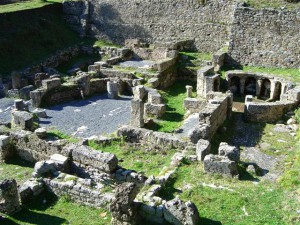 The archaeological site is located outside the village of Atsilochos, in Mountainous Arcadia. Remnants that have come to light include fragments of the old fortification, ruins of houses and public buildings, a sanctuary of Asclepius and baths that were probably connected to this deity, with a curative purpose. The baths are among the most important ones to be discovered from the ancient world. They included a special heating system, which was considered by the researchers to be an Arcadian innovation.
The archaeological site is located outside the village of Atsilochos, in Mountainous Arcadia. Remnants that have come to light include fragments of the old fortification, ruins of houses and public buildings, a sanctuary of Asclepius and baths that were probably connected to this deity, with a curative purpose. The baths are among the most important ones to be discovered from the ancient world. They included a special heating system, which was considered by the researchers to be an Arcadian innovation.
The city also seems to be connected with the ancient city of the same name located in the valley of Mesara, near Heraklion, Crete. It is very possible that the Cretan Gortys was created by inhabitants of the Arcadian one.
According to myth, Ancient Gortys was founded by Gortys, the brother of Agamedes, son of Stymphalus and great grandson of King Arcas of the Lycaonides people. He gave his name to the city and also to River Lousios, which is called Gortynios at the stretch from Gortynia up to its confluence with river Alfeios. In antiquity, it was one of the most important cities of Arcadia and, according to what little is known, one of the oldest.
The city is situated next to River Lousios, at an altitude of 350 metres, a short distance outside the village of Atsilochos, in mountainous Arcadia. It was one of the stops on the route followed by Spartan athletes when travelling to compete in the Olympic Games, as the ancient road of Olympia – Megalopolis – Mycenae – Isthmus – Athens passed through here.
The city was guarded by two acropolises with strong fortifications, built close to one another, at an altitude of approximately 480 metres. It also had several temples and public buildings, burial grounds, a sanctuary of Asclepius, as well as two large baths, which formed an integral part of the worship of this deity. The baths operated from the 2nd century BC and had a special heating system, which archaeologists believe was an Arcadian invention. There was also a temple dedicated to Asclepius containing the god’s cult statue made by the famous sculptor Skopas of Paros. So renowned was this temple, according to Pausanias, that even Alexander the Great visited it in 335 BC, offered a sacrifice to the god and dedicated his spear and chest armour.
The exact date of the foundation of ancient Gortys is not known, owing principally to the lack of relevant written evidence and findings. There are, however, findings dating to the Late Helladic (1600-1100 BC) and up to the Geometric Period (11th – 8th century BC), thus verifying its age. The city’s most important period is placed during the Classical and Hellenistic Periods, with its peak specifically around the 4th century BC. Its decline, on the other hand, appears to have come after the foundation of Megali Polis, in 368 BC, when Gortys, together with neighbouring cities, was forced to unite with it, thus losing its autonomy. As a result, a large part of its population relocated to the new city. The city appears to have been finally destroyed around the 12th century AD, during the Byzantine Period, by the Goths.
During its peak years however, Gortys was a lively city, participating in the events of the wider region throughout its history.
Source: www.mythicalpeloponnese.gr
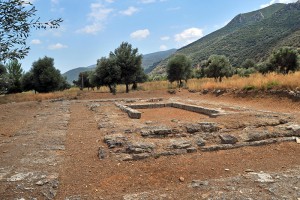 The archaeological site of ancient Troezen, homeland of mythical Thiseas, extends across a green land 3km away from the port of the town. It was the place where Phaedra and Hippolitus fell in love. At the site we find the ruins of the temple of Hippolitus founded by Diomedes and the buildings and the precinct constructed in the late 4th century or the early 3rd century B.C. over an ancient building. There are also ruins of ancient sanctuaries, walls, Phaedra’s monument, the Agora, the stadium and other buildings. All the findings are displayed in the museums of Poros and Athens.
The archaeological site of ancient Troezen, homeland of mythical Thiseas, extends across a green land 3km away from the port of the town. It was the place where Phaedra and Hippolitus fell in love. At the site we find the ruins of the temple of Hippolitus founded by Diomedes and the buildings and the precinct constructed in the late 4th century or the early 3rd century B.C. over an ancient building. There are also ruins of ancient sanctuaries, walls, Phaedra’s monument, the Agora, the stadium and other buildings. All the findings are displayed in the museums of Poros and Athens.
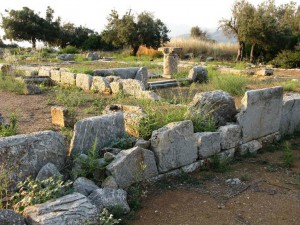 Surrounded by walls descending from the ancient citadel, the ruins of ancient Troezen, amidst olive groves and trees, are located to the west of the modern town of Trizina, on the northern slopes of mount Aderes, in a plain between two ravines. According to mythology, Troezene was the homeland of Theseus.
Surrounded by walls descending from the ancient citadel, the ruins of ancient Troezen, amidst olive groves and trees, are located to the west of the modern town of Trizina, on the northern slopes of mount Aderes, in a plain between two ravines. According to mythology, Troezene was the homeland of Theseus.
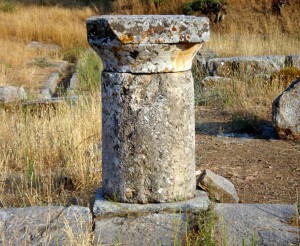 Its first king was Orus who passed his kingdom down to his grandson Althepus, son of Poseidon. After the reign of many kings, the kingdom came under the power of Pittheus, grandfather of Theseus who named the region Troezen after his dead brother, Troezen. The region is connected to the son of Theseus, Hippolitus. The second wife of Theseus, Phaedra fell in love with her young stepson and defamed him to his father. Hippolitus was killed by Poseidon following an order of Theseus. The worship of Hippolitus was connected to the worship of Asclepius. Asclepius brought Hippolitus back to life after request of Artemis. The sanctuary of Hippolitus is 800m away from the agora and it extends to 4000m². It was founded by Diomedes outside the walls of ancient Troezene because he had been saved from the bad weather when he was returning from Troy. The sanctuary’s precinct and buildings were built in the late 4th or early 3rd century B.C. around an older place of worship as indicated by the ceramic and pottery shards found on the site. It was a peripteral sanctuary with cella (inner shrine), pronaos (fore temple) and opisthonaos (rear temple).
Its first king was Orus who passed his kingdom down to his grandson Althepus, son of Poseidon. After the reign of many kings, the kingdom came under the power of Pittheus, grandfather of Theseus who named the region Troezen after his dead brother, Troezen. The region is connected to the son of Theseus, Hippolitus. The second wife of Theseus, Phaedra fell in love with her young stepson and defamed him to his father. Hippolitus was killed by Poseidon following an order of Theseus. The worship of Hippolitus was connected to the worship of Asclepius. Asclepius brought Hippolitus back to life after request of Artemis. The sanctuary of Hippolitus is 800m away from the agora and it extends to 4000m². It was founded by Diomedes outside the walls of ancient Troezene because he had been saved from the bad weather when he was returning from Troy. The sanctuary’s precinct and buildings were built in the late 4th or early 3rd century B.C. around an older place of worship as indicated by the ceramic and pottery shards found on the site. It was a peripteral sanctuary with cella (inner shrine), pronaos (fore temple) and opisthonaos (rear temple).
According to relevant inscriptions found on the site, a sanctuary of Asclepius was situated in the shrine. The remains of a spring and the foundation of other buildings, such as treatment rooms attest to the existence of the Asclepius sanctuary. The good climate of the region and the clean water led to the creation of such a sanatorium, which was however outshined by the Asclepius sanctuary in Epidaurus. The earthquake caused by the volcanic eruption of Methana in the 3rd century B.C. played a decisive role to the temple’s decline. The buildings were then destroyed and they were rebuilt during the Roman age. However, after the predominance of Christianity, the ancient material was used for the construction of churches. The Diocese church in the same area is considered a good example. It is an old Christian church dating back to the 6th century A.D. Apart from these monuments, the visitor can see ruins of the walls and of the monument of Phaedra, the Agora on the foot of the mountain, remains of ancient temples such as the temple of Venus of Kataskopia (espionage), of Artemis Sotiros (saver), Athena Sthenia and Zeus Sotiros (saver) and the ruins of the stadium and the theatre. The visitors will be amazed by a fortified tower, known as “the Palace of Theseus”, which was built in the 5th century but also has medieval elements. The ruins of a Roman building stand on the south of this tower, which is considered to be the Temple of the Muses. Among the findings at the site are gravestones, capitals, ceramic vessels and pottery, figurines, two statuettes and amphoras exposed at present at the Arcaelogical museum of Poros and the National Archaeological museum of Athens.
Source: www.mythicalpeloponnese.gr
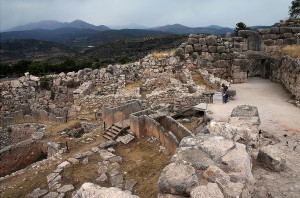 Mycenae, Homer’s Rich in Gold town, is located between two conical hills. According to the tradition it was founded by Perseas whose dynasty lasted three generations. After them, Mycenae was reined by the family of Atreus and it was during their rule that most of the monuments were built. Their decline started in the 12th century. The town was then occupied by the Dorians and after them it was conquered by Argos (468 B.C.). By the 2nd century B.C. Mycenae was ruined. The visitors will admire the “Lion Gate”, the “cyclopean walls”, the Atreus Palace” the Grave Circles A and B, the famous “Treasure of Atreus”, the “tholos tomb of Clytaemnestra” and many other constructions which will transfer visitors to mythical and glorious days.
Mycenae, Homer’s Rich in Gold town, is located between two conical hills. According to the tradition it was founded by Perseas whose dynasty lasted three generations. After them, Mycenae was reined by the family of Atreus and it was during their rule that most of the monuments were built. Their decline started in the 12th century. The town was then occupied by the Dorians and after them it was conquered by Argos (468 B.C.). By the 2nd century B.C. Mycenae was ruined. The visitors will admire the “Lion Gate”, the “cyclopean walls”, the Atreus Palace” the Grave Circles A and B, the famous “Treasure of Atreus”, the “tholos tomb of Clytaemnestra” and many other constructions which will transfer visitors to mythical and glorious days.
The Rich in Gold Acropolis of Mycenae is located in a strategic position, 10km outside the town of Argos, on the old national road to Corinth, burried in a rocky mountain barrow between two conical hills, Profitis Ilias and Sara.
Video by fabdrone
Perseus, son of Zeus and Danai, daughter of Akrisios, king of Argos and descendant of Danaos, is traditionally considered as its mythical founder. The dynasty of Persides was followed by Electrion, Sthenelon, son of Perseus and then by Eurystheas who was killed in an expedition. The place was then occupied by Atreus and Thiestis, descendents of Pelops. It was here that Agamemnon, son of Atreus, gathered all the Greeks that sacked Troy and spread the fame of Mycenae all over the world. Many tragic poets were inspired by the glory and the drama of this generation. The glory of Mycenae lasted until 1100 B.C. when the Dorians occupied Peloponnesus. The destruction continued in the subsequent centuries and in 468 B.C. Argos conquered the acropolis. In 150 B.C. the town was probably fully abandoned.
For many centuries this glorious land existed only in the imagination of poetry lovers. In 1876 Heinrich Schliemann, consulting the Homeric poems, began excavating and uncovered the palaces of Atreides and the brilliant Mycenaean civilization that dominated during 1600-1100B.C. Most of the monuments discovered belong to the Late Bronze Age between 1350-1200 B.C. However the site was first occupied in the Mesolithic period.
 At present the site hosts many impressive constructions. The visitors can follow the steps of Atreus and admire the “Lion Gate”, where two rampant lions are carved in stone relief, surrounded by the imposing “cyclopean walls”. At the main site one can see the well preserved royal courtyard, the main palace of Atreus and a series of constructions- probably private houses. The archeological findings at the site suggest a close relation between the Minoan and the Mycenaean art. Frescos and mosaic decorations belong to the Cretan Minoan artifacts. In a few meters further one can visit the remains of the Grave Circle A and outside the walls, to the west of the Lion Gate, the Grave Circle B with its 24 tombs, 14 of which are royal.
At present the site hosts many impressive constructions. The visitors can follow the steps of Atreus and admire the “Lion Gate”, where two rampant lions are carved in stone relief, surrounded by the imposing “cyclopean walls”. At the main site one can see the well preserved royal courtyard, the main palace of Atreus and a series of constructions- probably private houses. The archeological findings at the site suggest a close relation between the Minoan and the Mycenaean art. Frescos and mosaic decorations belong to the Cretan Minoan artifacts. In a few meters further one can visit the remains of the Grave Circle A and outside the walls, to the west of the Lion Gate, the Grave Circle B with its 24 tombs, 14 of which are royal.
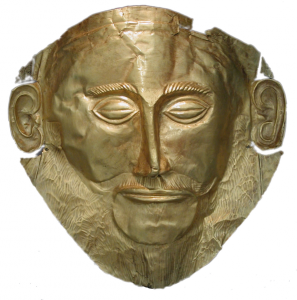 The underground cistern and the North Gate are of a great importance, too. The Treasury of Atreus is located at the site where golden objects were found, as well as the famous mask of Atreus. In a small distance lies the sevre Grave of Clytemnistra and the Grave of Aigisthos.
The underground cistern and the North Gate are of a great importance, too. The Treasury of Atreus is located at the site where golden objects were found, as well as the famous mask of Atreus. In a small distance lies the sevre Grave of Clytemnistra and the Grave of Aigisthos.
All of these monuments along with many other constructions make up the sights in the place where Homer’s greatest of men used to walk.
Source: www.mythicalpeloponnese.gr
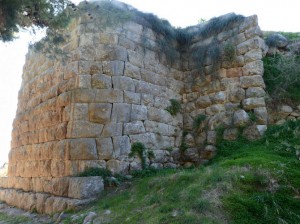 The charming and mystic acropolis of Ancient Asine is situated a few kilometers away from Tolo. It is built on a rocky hill called Kastraki, and it has a view to the sea. It was praised by Homer and other great poets and it became known worldwide by Seferis when he was awarded the Nobel Prize. The walls of the acropolis and the tower date back to the Hellenistic Era.
The charming and mystic acropolis of Ancient Asine is situated a few kilometers away from Tolo. It is built on a rocky hill called Kastraki, and it has a view to the sea. It was praised by Homer and other great poets and it became known worldwide by Seferis when he was awarded the Nobel Prize. The walls of the acropolis and the tower date back to the Hellenistic Era.
The excavations documented that the site was occupied for many centuries and they brought to light the great Mycenaean cemetery of Barbouna on the hill bearing the same name. A ceramic face mask of the King of Asine was discovered among the other findings.
 Next to the cosmopolitan town of Tolo, the acropolis of Ancient Asine lies suspended on a huge rock 52 meters tall and 330 meters long overlooking the coastal roads. A few meters towards the west lies another archaeological site, the Mycenaean necropolis of the Barbouna hill. This land was praised by many poets. Homer exalted its naval power and the grandeur of its almighty King. Its fame reached the whole world when Greek poet Seferis was awarded the Nobel Prize.
Next to the cosmopolitan town of Tolo, the acropolis of Ancient Asine lies suspended on a huge rock 52 meters tall and 330 meters long overlooking the coastal roads. A few meters towards the west lies another archaeological site, the Mycenaean necropolis of the Barbouna hill. This land was praised by many poets. Homer exalted its naval power and the grandeur of its almighty King. Its fame reached the whole world when Greek poet Seferis was awarded the Nobel Prize.
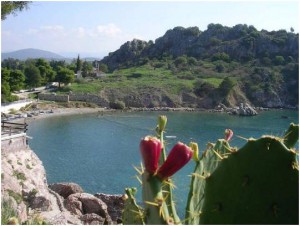 Ancient Asine was inhabited for many centuries. Its king participated in the Trojan War with a great naval power. In 1104 B.C. it was conquered by the Dorians who merged with the local population and created a powerful kingdom. However, in 740 B.C. it was destroyed by the Argians who put an end to its prosperity. The citizens of Asine left the town and settled in Messinia. There they founded the new town of Asine (Koroni). The town started regaining its past glory. The cyclopean walls and the tower date back to that period (3rd century B.C.), but in the subsequent centuries they were modified by the Byzantines, the Venetians and the Italians.
Ancient Asine was inhabited for many centuries. Its king participated in the Trojan War with a great naval power. In 1104 B.C. it was conquered by the Dorians who merged with the local population and created a powerful kingdom. However, in 740 B.C. it was destroyed by the Argians who put an end to its prosperity. The citizens of Asine left the town and settled in Messinia. There they founded the new town of Asine (Koroni). The town started regaining its past glory. The cyclopean walls and the tower date back to that period (3rd century B.C.), but in the subsequent centuries they were modified by the Byzantines, the Venetians and the Italians.
The excavations carried out between 1922 and 1930 were continued in the 70s and they document the continuous occupation of the town. They brought to light ruins of buildings and vases of the early Helladic, middle Helladic, Mycenaean, Geometric, Archaic and Hellenistic periods as well as the cemetery of Barbouna with the tombs of its mythical heroes. The offerings found document the commercial relations between Asine and other towns of the Aegean and Crete as well as the habits of its citizens. Among the findings, a ceramic funerary mask that is thought to belong to the “Ruler of Asine”. It is exposed in the Archaeological Museum of Nafplion.
Source: www.mythicalpeloponnese.gr
The Ancient Theater of Epidaurus is famous for its exceptional acoustics, its absolute symmetry and the way it “sits” in the landscape. It is considered as the biggest and most beautiful amplifier made of stone. It was built in the 4th century B.C. on the west side of mount Kynortion by Polykleitos and its capacity was extended in the 2nd century. Every summer, in its 14.000 seats, it welcomes the lovers of ancient drama who come to enjoy the plays of great tragic and comic poets.
 Alongside the Sanctuary of Asclepius, the exceptional theater of Epidaurus is built amphitheatrically on the west side of mount Kyniorto and it is one of the best preserved theaters of Ancient Greece.
Alongside the Sanctuary of Asclepius, the exceptional theater of Epidaurus is built amphitheatrically on the west side of mount Kyniorto and it is one of the best preserved theaters of Ancient Greece.
It was built in the 4th century by the great architect Polykleitos and it was initially designated for musical and singing contests and ancient drama performances linked to the worship of Asclepius. In the 2nd century B.C. the main theater (cavea) was extended to 14000 seats. In the following centuries, unlike many other ancient theaters, its form (cavea, orchestra, stage) did not change and remained continuously in use.
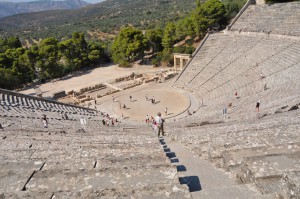 However, in 395 A.D. the Goths caused severe damage to the place, while in 426 A.D.. Theodosius II banned all activities at the sanctuary of Asclepius and the sanctuary was closed permanently. This great structure was brought to light 15 centuries later, in 1881, by the excavations of Panagis Kavadias and the Archaeological Company. Restoration works began in the 20th century in order to preserve this exquisite monument.
However, in 395 A.D. the Goths caused severe damage to the place, while in 426 A.D.. Theodosius II banned all activities at the sanctuary of Asclepius and the sanctuary was closed permanently. This great structure was brought to light 15 centuries later, in 1881, by the excavations of Panagis Kavadias and the Archaeological Company. Restoration works began in the 20th century in order to preserve this exquisite monument.
Today the theater is renowned for its perfect architecture and its astounding acoustics. It is considered to be the most perfect and great stone loudspeaker of the world. The three-section theater structure is perfectly represented in this theater. The main theater (cavea) consists of 55 rows of seats divided in two sections. The orchestra preserves its circular form while only the foundation is saved from the skene. On both sides columns of ionic style connect the skene with the cavea. Every summer since 1955, the year in which the Epidaurus Festival was established, great Greek and foreign actors perform ancient dramas and modern plays here.
Source: www.mythicalpeloponnese.gr
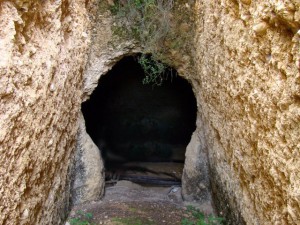 The archaeological site of the cemetery of Dendra with its royal tombs is already famous for the excavation of the bronze armor of Dendra, the most ancient armor found. The discovery brought to light the ancient burial habits and confirmed Homeric poems. The valuables, the everyday life objects, the elaborate jewelry and the figurines of reverence discovered document the wealth of that period. Recent excavations brought to light the remains of two horses and provided valuable insight on the rituals of the Mycenaean age.
The archaeological site of the cemetery of Dendra with its royal tombs is already famous for the excavation of the bronze armor of Dendra, the most ancient armor found. The discovery brought to light the ancient burial habits and confirmed Homeric poems. The valuables, the everyday life objects, the elaborate jewelry and the figurines of reverence discovered document the wealth of that period. Recent excavations brought to light the remains of two horses and provided valuable insight on the rituals of the Mycenaean age.
The archaeological site of the cemetery of Dendra is situated on a hill slope, on the west of the Mycenaean town of Midea, outside the village that bears the same name. It constitutes one of the biggest Mycenaean cemeteries of Peloponnesus.
 The excavations, that started during the spring of 1926 and were carried out in the following decades, brought to light the royal tombs; a tholos tomb and sixteen chamber tombs. The chamber tombs vary in shape and they were engraved in a soft rock on the hill slope. They consisted of three parts: the dromos, an inclining ramp, the stomion, narrow passage, and the chamber. The entrance to the tomb was walled by a dry masonry.
The excavations, that started during the spring of 1926 and were carried out in the following decades, brought to light the royal tombs; a tholos tomb and sixteen chamber tombs. The chamber tombs vary in shape and they were engraved in a soft rock on the hill slope. They consisted of three parts: the dromos, an inclining ramp, the stomion, narrow passage, and the chamber. The entrance to the tomb was walled by a dry masonry.
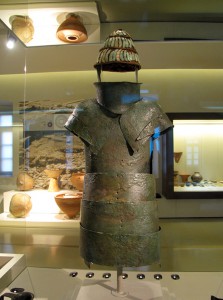 Among the findings at Dendra Cemetery, the one that stands out, is the oldest complete bronze armor. The necropolis uncovered the ancient burial habits of the Mycenaean age, and confirmed Homer, who exalted the Achaeans who wore bronze. Precious valuables, arms, tools, elaborate jewelry, figurines of worship and everyday life objects made of gold, silver, bronze, ivory and other materials confirm the wealth of that period. Recent excavations brought to light two prehistoric domestic horses, possibly battle steeds, which griped the archaeological community.
Among the findings at Dendra Cemetery, the one that stands out, is the oldest complete bronze armor. The necropolis uncovered the ancient burial habits of the Mycenaean age, and confirmed Homer, who exalted the Achaeans who wore bronze. Precious valuables, arms, tools, elaborate jewelry, figurines of worship and everyday life objects made of gold, silver, bronze, ivory and other materials confirm the wealth of that period. Recent excavations brought to light two prehistoric domestic horses, possibly battle steeds, which griped the archaeological community.
All of the findings attest that the site was occupied between 1500 and 1180 B.C. probably pertaining to the nearby acropolis of Midea. They are exposed in the archeological museum of Nafplion and the National Archeological Museum of Athens.
Source: www.mythicalpeloponnese.gr
The megalithic Mycenaean bridge of Kazarma stands imposing in the village Arcadicon and constitutes the oldest bridge in Europe that is still in use. It must have been constructed back in 1300 B.C. and it used to join Epidaurus, Mycenae and ancient Tiryns.
In the village called Arcadikon, on the way which joins Nafplion to Epidaurus predominates the Mycenaean “Bridge of Kazarma” , the oldest bridge in Europe. This imposing bridge, that constitutes another great creation of the Mycenaean age, was constructed around 1300 B.C. For its construction massive uncut limestone blocks were used, in accordance with the Mycenaean construction style that ordered no use of adjoining material. It is 22m long 5,6 m wide and 4m high, and based on remains of a still visible road suitable for vehicles across the bridge, it had been used to connect Epidaurus, Mycenae and ancient Tiryns. At the same time, it was also used as a dam for the raging torrents. The special characteristic of this bridge compared to others is the oblique wedge that holds the sides of the triangular passage in place.
Today, this arched bridge still in use by the inhabitants of the region, and four more placed close to each other, are there to remind us that on this specific land the glorious Mycenaean civilization was once born.
Source: www.mythicalpeloponnese.gr
The Pyramid of Hellinikon is located near the city of Argos, on an ancient road which once led from Argos to Tegea. The pyramid is preserved in good condition and it consists of a unique phenomenon and an archaeological mystery.
The Pyramid of Hellenikon is situated nine kilometres away from Argos, near the springs of the Erasinos river and on the main arterial road which in antiquity led from Argos to Tegea. The pyramid is a live proof of mythology which suggests that there was a relation between the land of Argos and the Egyptian civilization. There is a controversy about the date of this structure.
Based on the excavations carried out, it dates back to the late 4th century, but according to archaeologists, using new methods, it might overlap the construction of the pyramids in Egypt. The first theory seems to prevail.
 The Pyramid of Hellenikon is situated nine kilometres away from Argos, near the springs of the Erasinos river and on the main arterial road which in antiquity led from Argos to Tegea. The pyramid is a live proof of mythology which suggests that there was a relation between the land of Argos and the Egyptian civilization. There is a controversy about the date of this structure. Based on the excavations carried out, it dates back to the late 4th century, but according to archaeologists, using new methods, it might overlap the construction of the pyramids in Egypt. The first theory seems to prevail.
The Pyramid of Hellenikon is situated nine kilometres away from Argos, near the springs of the Erasinos river and on the main arterial road which in antiquity led from Argos to Tegea. The pyramid is a live proof of mythology which suggests that there was a relation between the land of Argos and the Egyptian civilization. There is a controversy about the date of this structure. Based on the excavations carried out, it dates back to the late 4th century, but according to archaeologists, using new methods, it might overlap the construction of the pyramids in Egypt. The first theory seems to prevail.
There are many theories on its use. The Greek traveler, Pausanias wrote in the 2nd century A.D. that the Hellinikon pyramid was a common tomb for soldiers. Others refer to the pyramid as a fryctoria, a tower used to send smoke signals. At the present it is believed that the pyramid served as a small observatory to control the surrounding area.
It consists of a unique architectural phenomenon and it is preserved in good condition. It reminds its visitors of the history of Argos.
Source: www.mythicalpeloponnese.gr
The sanctuary of Asclepius with its healing waters is situated between the hills of Titthios and Kynortio. For many centuries it constituted a cultural, religious and political center of great importance. It was here that the king of Epidaurus, Malos, founded the sanctuary of Apollo Maleatas and then his granddaughter, Koronis, gave birth to Apollo’s son, the god Asclepius. Thousands of sick people passed through the gates of the sanctuary in order to be cured by the god Asclepius. Alongside the sanctuary the visitor can admire the baths, the gymnasium, the tholos, the abaton, the sanctuary of Asclepius, the palaestra, the Stadium and many other monuments.
The ancient theater of Epidaurus is located in this archaeological site. The Sanctuary of Asclepius is located between the hills Titthio and Kynortio which were named after a nursing goat and a guardian dog that saved little Asclepius from hunger and beasts.
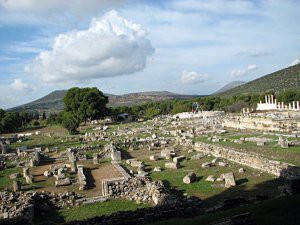 The sanctuary enjoyed great fame and was considered of the most important healing center of the time. It was the birthplace of medicine that was believed to be given to the people as knowledge from the god and it spread to the 300 Asklepeia in the Hellenic and the Roman world.
The sanctuary enjoyed great fame and was considered of the most important healing center of the time. It was the birthplace of medicine that was believed to be given to the people as knowledge from the god and it spread to the 300 Asklepeia in the Hellenic and the Roman world.
The adoration of medicine in this region did not start from Asclepius. Centuries before, between the 16th and 11th century B.C. on mount Kynortion behind the ancient theater there used to be an unusually large sanctuary dedicated to a healing goddess. At the same mount, in 800 B.C, according to the mythology, the king of Epidaurus, Malos, founded a sanctuary dedicated to Apollo Maleatas and later his granddaughter, Koronis, daughter of the king of Thessaly, Flegyas, gave birth to Asclepius, a fruit of her love with Apollo. During the 6th century B.C. the fame of Asclepius spread beyond the limits of Argolida and a second sanctuary was founded, one kilometer southwest, the Asklepion.
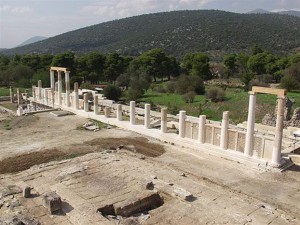 The ritual of healing gave great importance to the purifying significance of the water. In the following centuries, the sanctuary became very famous, and the worship continued, despite the destructions during the Roman period, until the official ban on ancient pagan religions in 426 A.D. by Theodosius the Great. Between 522 and 551 A.D. the site was abandoned following the destructive earthquakes.
The ritual of healing gave great importance to the purifying significance of the water. In the following centuries, the sanctuary became very famous, and the worship continued, despite the destructions during the Roman period, until the official ban on ancient pagan religions in 426 A.D. by Theodosius the Great. Between 522 and 551 A.D. the site was abandoned following the destructive earthquakes.
Panagis Kavvadias excavated the site in 1881, uncovering the sanctuary’s most important monuments.
Several buildings surround the temple. These include the Archaeological Museum, the Hostel, the Purifying Baths, and then the gymnasium and a Roman Odeon built in its yard. In the northeast part one can see the so-called Stoa of Kotyos, the temple of Artemis and the doric temple of Asclepius. Next to the temple lies the Abaton, where the patients’ hypnosis took place, the Tholos, a circular peristyle building, the Roman baths, a sacred road that lead to the Propylaia and the ruins of an early orthodox church. Also visible are the remains of the arena and the stadium. The most significant monument of the site is the well renowned Ancient Theater of Epidaurus, an architectural masterpiece.
Source: www.mythicalpeloponnese.gr

